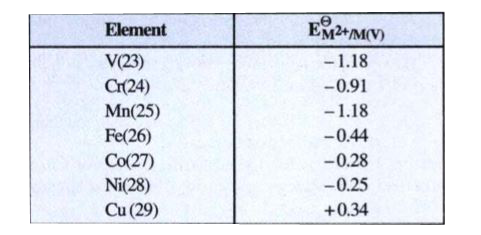Explain briefly how +2 state become more and stable in the first half of the first row transition elements with increasing atomic number?
To explain how the +2 oxidation state becomes more stable in the first half of the first row transition elements with increasing atomic number, we can break down the explanation into several steps:
1. Understanding the Transition Elements:
The first row transition elements include Scandium (Sc) to Zinc (Zn), which corresponds to atomic numbers 21 to 30. These elements have partially filled d orbitals.
2. Electron Configuration:
In the +2 oxidation state, these elements lose two electrons. For example, Scandium (Sc) has an electron configuration of (Ar) 3d¹ 4s². When it loses two electrons to form Sc²⁺, it loses the 4s electrons first, resulting in (Ar) 3d¹.
3. Filling of d Orbitals:
In the first half of the transition series (from Sc to Mn), the d orbitals are progressively filled with one electron at a time. For example:
- Sc: 3d¹
- Ti: 3d²
- V: 3d³
- Cr: 3d⁴
- Mn: 3d⁵
4. Stability Due to Electron Configuration:
As we move from Sc to Mn, each additional electron occupies a separate d orbital (Hund's rule), which minimizes electron-electron repulsion. This leads to a more stable configuration.
5. Increased Nuclear Charge:
With increasing atomic number, there is an increase in the positive charge of the nucleus (more protons). This increased nuclear charge attracts the electrons more strongly, enhancing the stability of the +2 oxidation state.
6. Absence of Electron Pairing:
In the first half of the series, there is no pairing of electrons in the d orbitals. Since there are no paired electrons, there is less repulsion among electrons, contributing to the stability of the +2 state.
7. Transition to the Second Half:
As we move into the second half of the transition series (from Fe to Zn), electron pairing begins to occur in the d orbitals. This pairing leads to increased electron-electron repulsion, which can destabilize the +2 state.
Conclusion:
Thus, the +2 oxidation state becomes more stable in the first half of the first row transition elements due to the filling of d orbitals without pairing, increased nuclear charge, and minimized electron repulsion.
---
The first row transition elements include Scandium (Sc) to Zinc (Zn), which corresponds to atomic numbers 21 to 30. These elements have partially filled d orbitals.
In the +2 oxidation state, these elements lose two electrons. For example, Scandium (Sc) has an electron configuration of (Ar) 3d¹ 4s². When it loses two electrons to form Sc²⁺, it loses the 4s electrons first, resulting in (Ar) 3d¹.
In the first half of the transition series (from Sc to Mn), the d orbitals are progressively filled with one electron at a time. For example:
- Sc: 3d¹
- Ti: 3d²
- V: 3d³
- Cr: 3d⁴
- Mn: 3d⁵
As we move from Sc to Mn, each additional electron occupies a separate d orbital (Hund's rule), which minimizes electron-electron repulsion. This leads to a more stable configuration.
With increasing atomic number, there is an increase in the positive charge of the nucleus (more protons). This increased nuclear charge attracts the electrons more strongly, enhancing the stability of the +2 oxidation state.
In the first half of the series, there is no pairing of electrons in the d orbitals. Since there are no paired electrons, there is less repulsion among electrons, contributing to the stability of the +2 state.
As we move into the second half of the transition series (from Fe to Zn), electron pairing begins to occur in the d orbitals. This pairing leads to increased electron-electron repulsion, which can destabilize the +2 state.
Thus, the +2 oxidation state becomes more stable in the first half of the first row transition elements due to the filling of d orbitals without pairing, increased nuclear charge, and minimized electron repulsion.
Topper's Solved these Questions
- THE D AND F BLOCK ELEMENTSBOOK - NCERT ENGLISHCHAPTER - THE D AND F BLOCK ELEMENTSEXERCISE - Exercise
38 Videos
- SURFACE CHEMISTRYBOOK - NCERT ENGLISHCHAPTER - SURFACE CHEMISTRYEXERCISE - Exercise
35 Videos
- THE P-BLOCK ELEMENTSBOOK - NCERT ENGLISHCHAPTER - THE P-BLOCK ELEMENTSEXERCISE - EXERCISE
74 Videos
Similar Questions
State the following:
How do the atomic radii change in a period with increasing atomic number?
View SolutionGiven below are the electrode potential values, EΘ for some of the first row of transition elements :

Explain the irregularities in these values on the basis of electronic structure of atoms.
View Solution
Knowledge Check
In which of the following 2nd anion is more stable than first?
AO2N−өCH2andF−өCH2BөCF3andөCCl3CF3C−өCH2andCl3C−өCH2DCH3−O∣∣C−өCH2andH2N−өCH2
Compare the stability of +2 oxidation state for the elements of the first transition series.
View SolutionIn a given transition series, there is no signifiecant change in the atomic radii of elements with increse in atomc number. Explain why.
View SolutionAssign reason for each of the following statement:
(i) The largest number of oxidation states are exhibited by the elements in their row transition elements.
(ii) The atomic radii decrease in Size with the increasing atomic number in the lanthanoid series
View SolutionExplain, why is the +2 oxidation state of lead more stable than the +2 oxidation state of tin.
View SolutionDecribe the general trends in the following properties of the first sereis of the transition elements :
(i) Stability of + 2 Oxidation state
(ii) Formation of oxometal ions.
View Solution(a) Describe the general trends in the following properties of the first series of the transition elements:
(i) Stability of +2 oxidation state (ii) Formation of oxometal ions
(b) Assign reason for each of the following:
(i) Transition elements exhibit variable oxidation states.
(ii)Transition metal ions are usually coloured
View SolutionTo what extent do the electronic configurations, decide the stability of oxidation states in the first series of the transition elements? Illustrate your answer with examples.
View Solution
